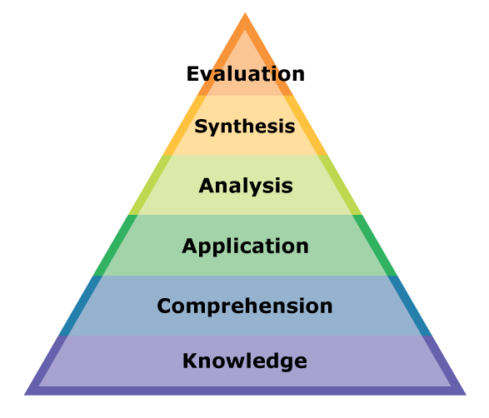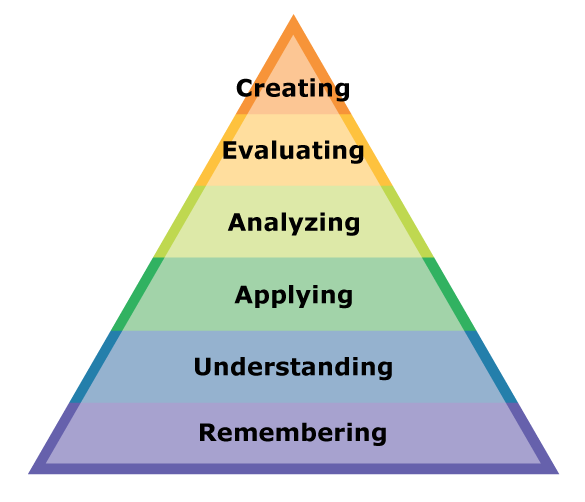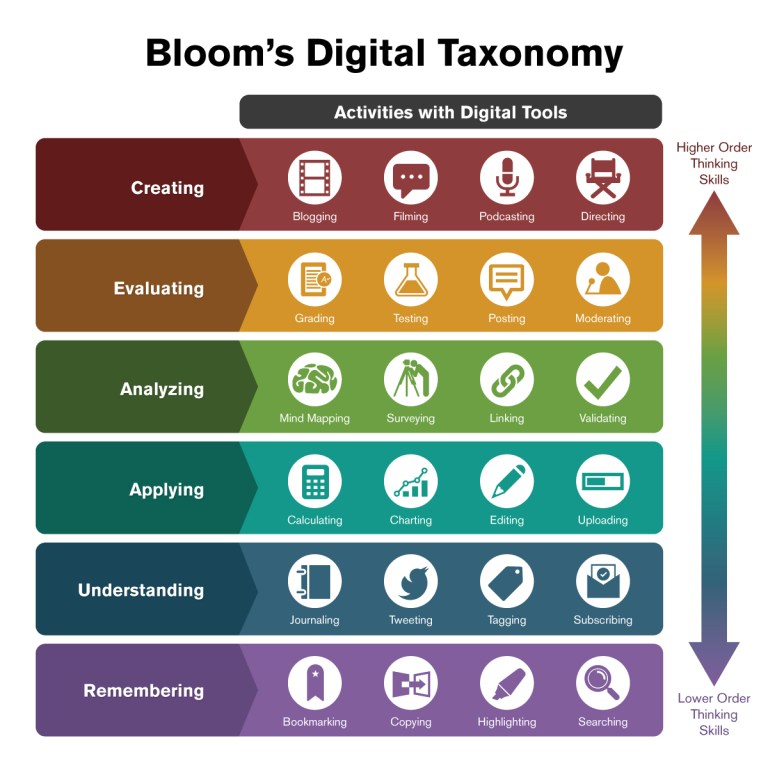Writing learning objectives and establishing alignment between them and your materials and assignments is one of the most essential parts of course design.
Contents
Click on the links following to navigate directly to each topic.
Creating Alignment
Alignment refers to the relationship between the course materials, assignments, and learning objectives in your course. When a course has good alignment, the first two elements (learning materials and assignments) work together to help students master the third element (learning objectives). Alignment ensures that students clearly understand what’s required for assignments and have the resources they need to fully complete them. It also helps you plan the structure of your course and devise good assessment strategies.
We’ve created a couple of planning guides to help you design a course that has good alignment. Our Course Design Blueprint is based on Dee Fink’s Significant Learning model, and our QM Lesson Blueprint is based on Quality Matters course design standards. (Note that you’ll need to be logged in to your Maine.edu account to access these files, and when you click the link, you’ll be prompted to make a copy to save in your Google Drive account.)
Writing Learning Objectives
Learning objectives are clear and concise statements about the knowledge and skills students will acquire by the end of your course. Well-designed blended and online courses specify learning objectives for both the course overall and each individual lesson.
Keep in mind the following characteristics as you write course- and lesson-level learning objectives:
- Student-centered: The learning objective uses active verbs and outlines student competencies.
- Measurable: Outlined student competencies can be systematically evaluated and assessed.
- Clear and concise: Only the components to be evaluated are included.
Consider these examples of ways to reword learning objectives so that they include these characteristics.
| Characteristic | Not Met | Met |
|---|---|---|
| Student-centered | Different theories of student development will be explored through lectures, readings, and assignments. | You will name student development theories and describe key characteristics that distinguish them. |
| Measurable | You will understand symbolism. | You will identify examples of symbolism in poetry and incorporate symbolism in your own writing. |
| Clear | You will evaluate the Pop Art movement. | You will evaluate the role of Pop artists in altering the definition of fine art. |
| Concise | You will analyze American foreign policy from 18th-century diplomatic relations with Europe to the Monroe Doctrine, considering the ways in which shifts from expansionism and Manifest Destiny to isolationism and protectionism impacted relations with neighboring nations and American Indians. | You will analyze how changes in American foreign policy during the 18th and 19th centuries impacted relations with neighboring nations and American Indians. |
Focus On Outcomes
In addition, your learning objectives should be outcome based rather than task based. In other words, they should specify the skills and knowledge students will be able to demonstrate once they’ve mastered the lesson rather than the assignments or activities they’ll actually be completing within the lesson. One workaround for this issue is to think of each learning objective as starting with the phrase,
“Upon completion of this lesson, you should be able to…”
Consider the revised learning objectives below as examples of ones that have been rewritten to be outcome rather than task based.
| Task-Based | Outcome-Based |
|---|---|
| You will write a paper about French Colonialism’s impact on modern-day Africa. | …describe 3 examples of French Colonialism’s impact on modern-day Africa. |
| You will add a 300-word post to the discussion board comparing and contrasting key traits of Modernism and Postmodernism. | …compare and contrast key traits of Modernism and Postmodernism. |
| You will demonstrate on a mannequin the 4 steps to administer CPR. | …demonstrate the 4 steps used to administer CPR. |
| You will create an Excel spreadsheet that calculates the cost basis of an asset. | …calculate the cost basis of an asset. |
As these examples demonstrate, sometimes all that’s required to change a task-oriented learning objective to an outcome-oriented one is removing wording about the format for its corresponding assignment.
Get to Know Measurable Verbs & Bloom’s Taxonomy
One of the most common mistakes you can make when writing learning objectives is starting them with a non-measurable action verb like one of the following:
- understand,
- know,
- learn,
- become familiar with, or
- demonstrate an understanding of.
These verbs are problematic because they don’t describe measurable actions students will take to demonstrate that they’ve mastered a concept or skill. In addition, these verbs don’t clarify the level of cognition expected of students. Ideally, anyone should be able to read your course objectives and see a clear connection to a specific level of Bloom’s taxonomy.
The first version of Bloom’s taxonomy was established in the 1950s by a group of educators led by psychologist Benjamin Bloom; it identified 6 levels of intellectual behavior for classifying learning activities and objectives. Typically, they’re pictured as a pyramid, with lower-order thinking skills (knowing, comprehending) at the pyramid’s base and higher-order thinking skills at its peak (synthesizing, evaluating).
Bloom’s 1950s version was revised in 2000 by Lorin Anderson, one of Bloom’s former students, and David Krathwohl, one of Bloom’s original collaborators. One of the most significant changes made by Anderson and Krathwohl was the placement of “creating” at the top of the pyramid. In Bloom’s original taxonomy, “evaluation” was considered the highest level of cognition, with “synthesis” immediately below it. To reflect changes in teaching and learning scholarship and practice, Anderson and Krathwohl renamed synthesis as “creating” and moved it to the top of the cognitive hierarchy.


While you might already be familiar with this pyramid-style representation, you might not realize that Bloom’s taxonomy actually consists of two dimensions. Rex Heer at Iowa State University’s Center for Excellence in Learning and Teaching created a chart to illustrate the relationship between the cognitive-process dimension (the pyramid) and the knowledge dimension of Bloom’s taxonomy. The knowledge dimension begins with concrete (factual) knowledge at its base and moves toward more abstract (metacognitive) knowledge in the upper left. The addition of the metacognitive level to the knowledge dimension was another key change that Anderson and Krathwohl introduced when they revised Bloom’s taxonomy in 2000.

For a printable version of Heer’s chart with additional explanation from its author, review “A Model of Learning Objectives” (PDF download).
Update to Digital
In 2008, educator Andrew Churches created Bloom’s Digital Taxonomy, which includes verbs associated with digital technologies. It models Bloom’s stages along a continuum, progressing from lower-order to higher-order thinking skills (outlined in a bottom-to-top orientation in Carranza’s infographic below).

Image Credit: Ron Carranza, Arizona State University (Sneed, 2016).
The following table lists additional measurable verbs for digital technologies that correspond with each of Bloom’s 6 stages. Review the full Bloom’s Digital Taxonomy chart (PDF download) for even more examples.
| Remembering | Understanding | Applying | Analyzing | Evaluating | Creating |
|---|---|---|---|---|---|
| bookmarking, defining, describing, identifying, matching, naming, recalling, reorganizing, retelling, searching, selecting, visualizing | annotating, categorizing, differentiating, discussing, estimating, explaining, grouping, journaling, paraphrasing, predicting, tagging | articulating, calculating, changing, charting, collecting, constructing, displaying, examining, interviewing, editing, hacking, presenting | appraising, classifying, deconstructing, illustrating, integrating, linking, mind mapping, organizing, planning, prioritizing, questioning, structuring | assessing, commenting, concluding, critiquing, defending, grading, hypothesizing, justifying, moderating, persuading, reframing, validating | adapting, blogging, composing, designing, filming, podcasting, remixing, roleplaying, simulating, wiki building, writing |

Want to learn how to hone your course’s learning objectives through an example?
Check out our two-part blog post on learning objectives! It clearly explains through an example course the point of writing learning objectives, how to write (or rewrite) good ones, and what to do with them once you’ve written them (10–15-minute reading time).
Collaborating on Learning Objectives
One of CTEL’s learning designers can suggest ways to re-word learning objectives if you find that yours sound repetitive or unclear, if you’re concerned about incorporating hard-to-measure learning goals into your course, or if you simply want to bounce ideas off of someone. Email ctelhelp@maine.edu to make an appointment!
References & Further Reading
- Anderson, L. W., & Krathwohl, D. R. (Eds.). (2001). A taxonomy for learning, teaching, and assessing: A revision of Bloom’s Taxonomy of Educational Objectives. New York, NY: Longman.
- Bloom, B. S. (1956). Taxonomy of educational objectives, handbook I: The cognitive domain. New York, NY: David McKay.
- Churches, A. (2008). Bloom’s digital taxonomy. Education Origami. Retrieved from http://www.ccconline.org/wp-content/uploads/2013/11/Churches_2008_DigitalBloomsTaxonomyGuide.pdf
- Fink, L. D. (2013). Creating significant learning experiences: An integrated approach to designing college courses. San Francisco, CA: Jossey-Bass.
- Heer, R. (2012). A model of learning objectives based on “A Taxonomy for Learning, Teaching, and Assessing: A Revision of Bloom’s Taxonomy of Educational Objectives.” Iowa State University Center for Excellence in Learning and Teaching. Retrieved from http://www.celt.iastate.edu/wp-content/uploads/2015/09/RevisedBloomsHandout-1.pdf
- Sneed, O. (2016, May 9). Integrating technology with Bloom’s taxonomy [Blog post]. TeachOnline. Retrieved from https://teachonline.asu.edu/2016/05/integrating-technology-blooms-taxonomy/
- “Standards from the Quality Matters Higher Education Rubric, 6th Edition.” (2018). Quality Matters. Retrieved from https://www.qualitymatters.org/sites/default/files/PDFs/StandardsfromtheQMHigherEducationRubric.pdf
